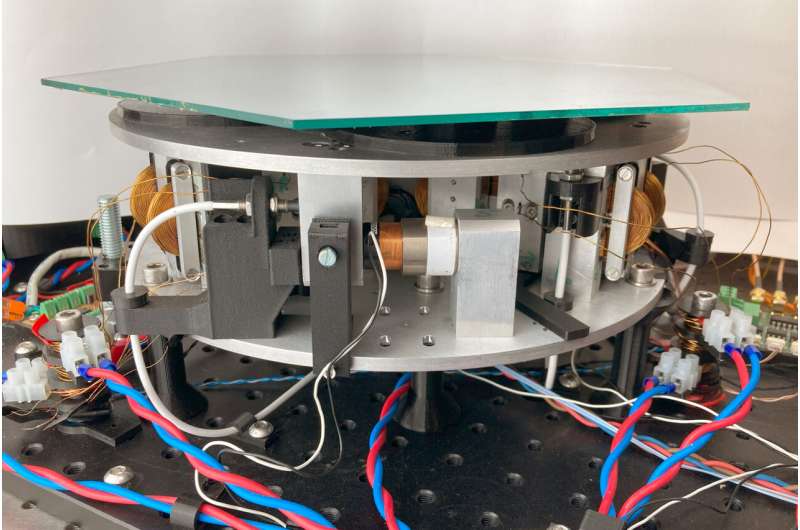This article has been reviewed according to Science X's editorial process and policies. Editors have highlighted the following attributes while ensuring the content's credibility:
fact-checked
trusted source
proofread
The magnet trick: New invention makes vibrations disappear

When everything shakes, precision is usually impossible—everybody who has ever tried to take a photo with shaky hands or make handwritten notes on a bumpy bus journey knows that. With technical precision measurements, even much smaller vibrations are a major problem, for example, with high-performance microscopes or precisely aligned telescope mirrors. Even the smallest vibrations, which are not even perceptible to humans, can render the measurement result unusable.
A new type of vibration damping technology has now been invented at Tu Wien that solves such problems in an unusual way: electropermanent magnets are used. These are magnets that, like ordinary permanent magnets, maintain their magnetism permanently without the need for a power supply, but which are also fitted with a coil so that their magnetization can be changed extremely fast using an electrical pulse. This makes it possible, for example, to actively suppress vibrations in mirrors in large telescopes and thus dramatically increase their performance.
The study is published in the journal IEEE Transactions on Industrial Electronics.
A floating platform with nanometer precision
The vibration damping system at Tu Wien consists of a permanently mounted base and a free-floating platform above it. The platform is suspended in the air, kept in place by strong magnetic forces. Several electromagnetic actuators can then fine-tune the position of the platform with high precision in fractions of a second—even when a load of several kilograms is mounted on this platform.
"In sensitive applications, such as the positioning of mirror segments, the position of this platform must be kept stable to within a few tens of nanometers," says Prof. Ernst Csencsics from the Institute of Automation and Control Technology at Tu Wien.
"This is only possible if you can compensate for even tiny ground vibrations, such as those that occur when someone walks past outside the laboratory, or those caused by normal building vibrations."
The position of the platform must therefore be measured extremely accurately and any movement must be counteracted immediately. This makes it possible to suppress vibrations very efficiently, especially low-frequency vibrations, which are usually a problem in such applications.
Electromagnets need constant power
"Electromagnets are usually used for such active vibration damping," explains Institute Director Prof Georg Schitter. "A current flows through coils in a magnetic field, and depending on how strong this current is, different forces can be generated. This works very quickly and precisely."
One major disadvantage of this technology, however, is that the current must flow continuously, otherwise the magnetic forces disappear instantly. A permanent magnet, on the other hand, can maintain its magnetic properties for any length of time without any external energy supply—once it has been magnetized by a very strong magnetic field.
Everyday permanent magnets, as we know them from magnetic boards or fridge magnets, are also created in this way: You need a suitable, magnetizable material and expose it to a strong magnetic field once. This creates a magnetic order in the material, causing it to remain magnetic permanently.
Remagnetizing permanent magnets in a targeted manner
The researchers have now succeeded in combining the advantages of electromagnets and permanent magnets in vibration damping using a so-called electropermanent magnet.
"This is a permanent magnet that is also fitted with a coil," says Csencsics.
As long as the strength of the permanent magnet is in the correct range, it does not require any power and the hovering platform is held in place. Only small corrective measures by the actuators are necessary to compensate for vibrations.
However, if the strength of the permanent magnet is no longer appropriate, for example because the weight resting on the hovering platform has changed or because it needs to be tilted, then more drastic methods are used: A short, strong current pulse is sent through the coil, creating a very strong magnetic field for a moment and thus also changing the magnetization of the permanent magnet.
By selecting the right magnetic pulse strength, the permanent magnet can be set to a new operating point, at which it then remains constant again without the need for an energy supply.
Working prototype, patent pending
This control can be automated: The system automatically recognizes whether it is still close to the desired operating point or whether remagnetization is necessary.
"We have developed the necessary control technology over the last two years and it is already working very well," says Csencsics. The invention has already been patented with the support of Tu Wien's research and transfer support team.
"With our prototype, we have shown that extremely precise and energy-saving vibration suppression is possible," says Schitter.
"The technology would be perfect for large telescopes, for example, which consist of several mirror segments. The telescope must be able to be aligned to different areas of the sky, and the mirrors must then be aligned with high precision and kept stable in every position. This is exactly what our technology would be ideal for."
In principle, however, the technology of electro-permanent magnet vibration damping could of course also be applied to other areas, such as the precision production of semiconductor chips and large high-quality optics, adaptive actuators or laboratory-based precision measurement technology.
"Wherever you need the highest possible precision that could be disturbed by vibrations, our technology is an interesting solution," the researchers say.
More information: Alexander Pechhacker et al, Integrated Electromagnetic Actuator With Adaptable Zero Power Gravity Compensation, IEEE Transactions on Industrial Electronics (2023). DOI: 10.1109/TIE.2023.3288176















